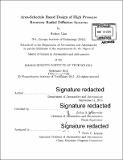Area-schedule based design of high pressure recovery radial diffusion systems
Author(s)
Gao, Ruhou
DownloadFull printable version (17.12Mb)
Other Contributors
Massachusetts Institute of Technology. Department of Aeronautics and Astronautics.
Advisor
Zoltán S. Spakovszky.
Terms of use
Metadata
Show full item recordAbstract
To address the shortcomings of the commonly used channel diffuser and cascade design perspectives, a streamtube perspective is adopted by carefully scheduling the streamtube area with special attention to the diffuser entry region. A design framework for radial diffusion systems is developed based on area scheduling the vaned diffuser. The vaned diffuser and volute designs are assessed numerically through RANS calculations and validated by full-scale compressor experiments. The investigations revel that it is mainly the diffuser area ratio and effective non-dimensional diffusion length that set diffuser performance. A careful balance between these two parameters is shown to enable high diffuser pressure recovery. The diffusion in the semi-vaneless-space, controlled chiefly by the vane suction side geometry, plays a key role in improving diffuser performance. Removing excess thickness from the suction side eliminates flow overspeed, increases effective diffusion length, and leads to higher pressure recovery at reduced stagnation pressure loss. The pressure side thickness distribution controls the channel area schedule. Thin leading edges ensure smooth flow area transition into the channel, and reduce the vane upstream influence and therefore pressure fluctuations as perceived by the impeller. A diffuser design based on the area schedule approach is tested experimentally. A 1.8 fold improvement in diffuser performance parameter CP/Cp,t, where Cp and Cp,t are the diffuser static pressure recovery and the diffuser stagnation pressure loss coefficients respectively, is achieved. In addition, a 0.8% point increase in impeller isentropic efficiency due to reduced vane upstream influence and a 0.74% point increase in impeller-diffuser efficiency are demonstrated. The impact of the volute on diffuser and overall diffusion system performance is also assessed. High diffuser exit Mach numbers and a low volute inlet swirl parameter are shown to reduce volute performance.
Description
Thesis: S.M., Massachusetts Institute of Technology, Department of Aeronautics and Astronautics, February 2016. Cataloged from PDF version of thesis. "September 2015." Includes bibliographical references (pages 111-112).
Date issued
2016Department
Massachusetts Institute of Technology. Department of Aeronautics and AstronauticsPublisher
Massachusetts Institute of Technology
Keywords
Aeronautics and Astronautics.